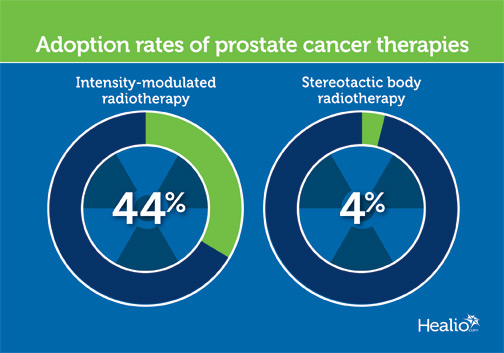Prostate cancer therapies show different rates of adoption
Two prostate cancer treatments have demonstrated sharp differences in adoption since they became widely available, study data showed.
“When [intensity-modulated radiotherapy] entered the market in 2001, it offered conceptual advances over its predecessor, 3-dimensional conformal therapy, in terms of increased precision, but it had yet to accrue long-term data regarding its comparative cancer control, complications, or mortality,” Bruce L. Jacobs, MD, MPH, assistant professor of urology at the University of Pittsburgh School of Medicine, and colleagues wrote. “Similarly, when [stereotactic body radiation therapy] entered the market in 2007, it offered conceptual advances over [intensity-modulated radiotherapy] in terms of a shorter duration of treatment and had also not yet accrued long-term data regarding its comparative effectiveness. Despite these similarities, early data suggest that these treatments were adopted at different rates.”
Researchers used the SEER database to identify patients with prostate cancer — all aged 66 years or older — who received intensity-modulated radiation therapy between 2001 and 2005, as well as those who underwent stereotactic body radiation therapy between 2007 and 2011. New therapies compared with existing therapies served as the primary outcome. .
Twenty-one percent (n = 5,680) of patients underwent intensity-modulated radiotherapy instead of radiation between 2001 and 2005. Those who received the newer therapy were older, lived in more populated areas and had higher grade tumors (P < .05).
Between 2007 and 2011, 2% of patients received stereotactic body radiation therapy (n = 595). Those who received the novel treatment appeared more likely to live in the Northeast, live in more populated areas, have lower grade tumors and be white (P < .05).
After Jacobs and colleagues adjusted for clinical and cohort demographic factors, the early adoption rate remained substantially higher for intensity-modulated radiotherapy compared with stereotactic body radiation therapy (44% vs. 4%; P < .01).
The researchers acknowledged limitations with the study, including wrote that the study relied on information from the SEER database, included very few patients who had undergone stereotactic body radiation therapy and focused on two different time periods that may have been confounded by different sets of factors.
They added, however, that the study had merit for three reasons: it provided evidence of different adoption rates for the therapies, and “emphasized the importance of critically examining the incentives and disincentives related to adoption and of revisiting effectiveness as more long-term data become available.
“Third, if longer term evidence supports [stereotactic body radiation therapy] as a comparable treatment, then transitioning toward [stereotactic body radiation therapy] may reduce the treatment burden for patients and lower the costs for our health care system,” Jacobs and colleagues wrote. – by Andy Polhamus
Disclosure: Jacobs reports fees from ViaOncology unrelated to this study. Please see the study for a full list of all other researchers’ relevant financial disclosures.


